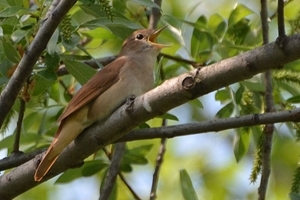Nightingale
A secretive bird with a famous song
 When I was a child, I used to hear a nightingale (Luscinia megarhynchos) singing from the woodland outside my bedroom window at night. Or that is what I thought it was when I was eight years old, but I expect it was more likely to have been a hope rather than reality – but I like to think it was a nightingale! However, this bird has always had air of mystery to me; it has peppered our culture and with its extremely secretive behaviour, one feels extremely lucky to hear its song, let alone see one!
When I was a child, I used to hear a nightingale (Luscinia megarhynchos) singing from the woodland outside my bedroom window at night. Or that is what I thought it was when I was eight years old, but I expect it was more likely to have been a hope rather than reality – but I like to think it was a nightingale! However, this bird has always had air of mystery to me; it has peppered our culture and with its extremely secretive behaviour, one feels extremely lucky to hear its song, let alone see one!
Nightingales are extremely local in their distribution in the UK and like nothing better than to hide away and skulk in bushes and deep thickets when they arrive in April. However, in much of southern Europe they are common and more easily seen.
Nightingales are slightly larger than our robins, about 15-17cm in length, with a rather plain cryptic brown appearance and a robust, broad tail. They could be referred to quite rudely as a LBJ – a “Little Brown Jobby”, which birders like to use to describe little drab-looking brown birds. But what they lack in appearance, they definitely make up with their song!
While here, male nightingales sing their enchanting, famous song at night until paired up in May, after which time their song is limited to dusk and dawn into June, which is a fast succession of high, low and rich notes that few other species can match. It is a song that will certainly stop you in your tracks!
Females lay one to two clutches a year. The first clutch is laid in May of four to five eggs, which are incubated for 14 days by the female, and the chicks fledge from the nest from 11 to 13 days, before birds depart for Africa in late summer. Nightingales have a typical lifespan of two years, but one individual has been aged via ringing at just over eight years old!
However, as wonderful as this species is, it is sadly in declining in both numbers and range and is now only found in a small area of southern and eastern England during the breeding season. England represents the northern edge of the global breeding range of the nightingale, with breeding mostly confined to an area south of the Severn-Wash line and east from Dorset to Kent. The highest densities are found in the southeast – Essex, Suffolk, Norfolk, Hampshire, Kent and Sussex – whereas counties at the range edge are increasingly characterised by a small number of sites of relatively high population density. Such sites become increasingly isolated as birds disappear from surrounding countryside.
The reasons for this decline are thought to encompass the degradation and loss of the scrubby woodland habitat upon which nightingales depend to breed, including by the increasing number of browsing deer. It is estimated that there are only 5,550 breeding males in the UK in 2012 (BTO), which is a 48% decrease in UK breeding population 1995-2020 (BTO).
So, what can we do to help this iconic species before it disappears from our shores?
There are two main contributors to the decline of this species: the habitat degradation of both breeding and overwintering habitat. There is strong evidence that increasing and intense deer grazing is having a negative effect on nightingale numbers, as well as many other species, by reducing the quality of the coppice as a habitat for nightingales and removing the low vegetation and thick habitat they require.
Several studies have highlighted the benefit of habitat management for this species, involving coppicing and control of deer numbers to promote the varied vegetation structure that nightingales need.
What do nightingales need?
Our nesting nightingales typically require closed-canopy scrub or young woodland, with bare ground under the canopy for feeding, but also area of low, thick vegetation, generally associated with secondary succession and early regeneration after coppicing (Hewson et al. 2005, Wilson et al. 2005b). Canopy height in territories occupied by nightingales is usually less than four metres in height (Wilson et al. 2005b) and nests are built on or close to the ground, in a thick field layer that will provide cover for nests and a refuge for newly fledged young.
As said before, isolated populations are at risk of being lost, and the habitat nightingales require is either gone or heading that way. So, when you think about what the management plan is for your land – your scrubby bit of thicket, your hazel woodland, the new woodland, your deer management plan or for your messy part the farm or garden – have a thought for the nightingale and what they need before they disappear completely, and work with your neighbours to connect, create and manage this habitat and deer numbers at a landscape scale.
Megan Lock
Advisory
Image credit: Noel Reynolds